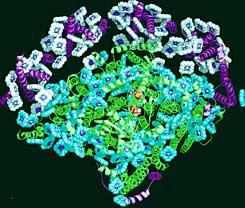This is how the system is built that enables life on earth
24.12.2003
By: Marit Selvin
[
The structure of the "Light System I". The proteins are the green and purple chains, molecules approx

One of the most important systems for sustaining life on Earth is the system that performs photosynthesis. In the process of photosynthesis, the green plants absorb carbon dioxide from the air and use the sun's energy to produce sugar from it. The solar energy that is absorbed by the plants turns into chemical energy that is stored inside the sugar molecules, and in the complex processes that take place in the plant, most of the materials that make up the building blocks of the living cell are formed. During the process, oxygen is released into the air, which is the main source of breathing for living creatures on Earth.
The green plants, algae and certain bacteria are the only ones in nature capable of carrying out photosynthesis and releasing oxygen, on which the existence of most life forms on the planet actually depends. Two huge protein structures are responsible for the execution of the process.
The molecular structure of one of these two structures has now been deciphered for the first time by a team of researchers from Tel Aviv University and was published a week ago in the journal "Nature".
Those responsible for absorbing the sun's energy and starting the photosynthesis process are the chlorophyll molecules found in the leaves of the green plants, inside a tiny organelle called a chloroplast (green body). Scientists believe that the chloroplast evolved from a bacterium that penetrated about 3 billion years ago into cells that floated in the oceans, at a time when the atmosphere was poor in oxygen and therefore the development of developed life forms was not possible.
In the cells containing the chloroplast, the process of photosynthesis began to take place, during which oxygen was emitted into the atmosphere. During evolution, algae and later land plants developed from these cells. The emission of oxygen from the plants led to an increase in the concentration of oxygen in the atmosphere, and eventually this concentration reached 20% and enabled the development of life on Earth.
The two protein structures in which the processes of photosynthesis occur are called "light system I" and "light system II". Light system I is responsible for the creation of sugars, proteins and other nutrients and the preservation of the energy absorbed from the sun; The Or II system uses light energy to split the water molecules that participate in the process and release the oxygen.
"Of all life processes, the process of photosynthesis is the most perfect in terms of its efficiency," says Prof. Nathan Nelson of the Faculty of Life Sciences at Tel Aviv University, who headed the team that deciphered the structure of Or System I. "In this system there are close to 200 chlorophyll molecules, which absorb the The photons of the sunlight and make it possible to convert light energy into chemical energy with almost 100% efficiency. This efficiency has no equal in other chemical or biological systems."
Two years ago, scientists succeeded in deciphering the structure of the light absorption system of a photosynthetic bacterium living in the sea. Many laboratories around the world have tried to isolate the two structures of the light systems in the chloroplasts of green plants to see how they differ from the photosynthetic system in bacteria, which is more primitive. This would have made it possible to stand on the evolutionary processes that enabled the transition from the photosynthetic bacteria to the developed plants.
Nelson's student, Adam Ben-Shem, succeeded as part of his doctoral thesis in extracting, purifying and crystallizing the Or I system from crushed pea leaves, and with the help of the crystal researcher Prof. Felix Prolov, also from the Faculty of Life Sciences, the crystal structure of the system is deciphered. To find out the structure of any substance, a protein for example, the protein is isolated and purified and crystallized in a solution. A special device sends X-rays to the crystal and based on the image of the scattering of the rays by the crystal, it is possible to calculate the electron density in the crystallized protein and obtain its three-dimensional image.
"16 different proteins can be identified in the crystal, and among them are scattered 167 chlorophyll molecules and other molecules that contribute to the photosynthesis process," says Nelson. "This is the most complicated natural structure that has been deciphered."
"The structure we uncovered clearly shows how 1.2 billion years ago, fateful processes took place that allowed the occupation of the surface of the oceans and the surface of the earth by living creatures," says Nelson. "Until then, the ancient life forms were concentrated in the depths of the oceans, where the light intensity was relatively low. The transition to the upper water layer of the oceans and land and the development of the photosynthetic process enabled the development of more developed life forms. But the transition from deep water to surface water and land involved contact with solar radiation, which did not reach the depth of the ocean. No life form could have evolved under such radiation conditions. It became clear to us that two proteins out of the 16 discovered in the structure of light system I provide protection against the strong light intensities of the sun on Earth. These two proteins actually enabled the development of life."

One response
My mother has a son named Yotam